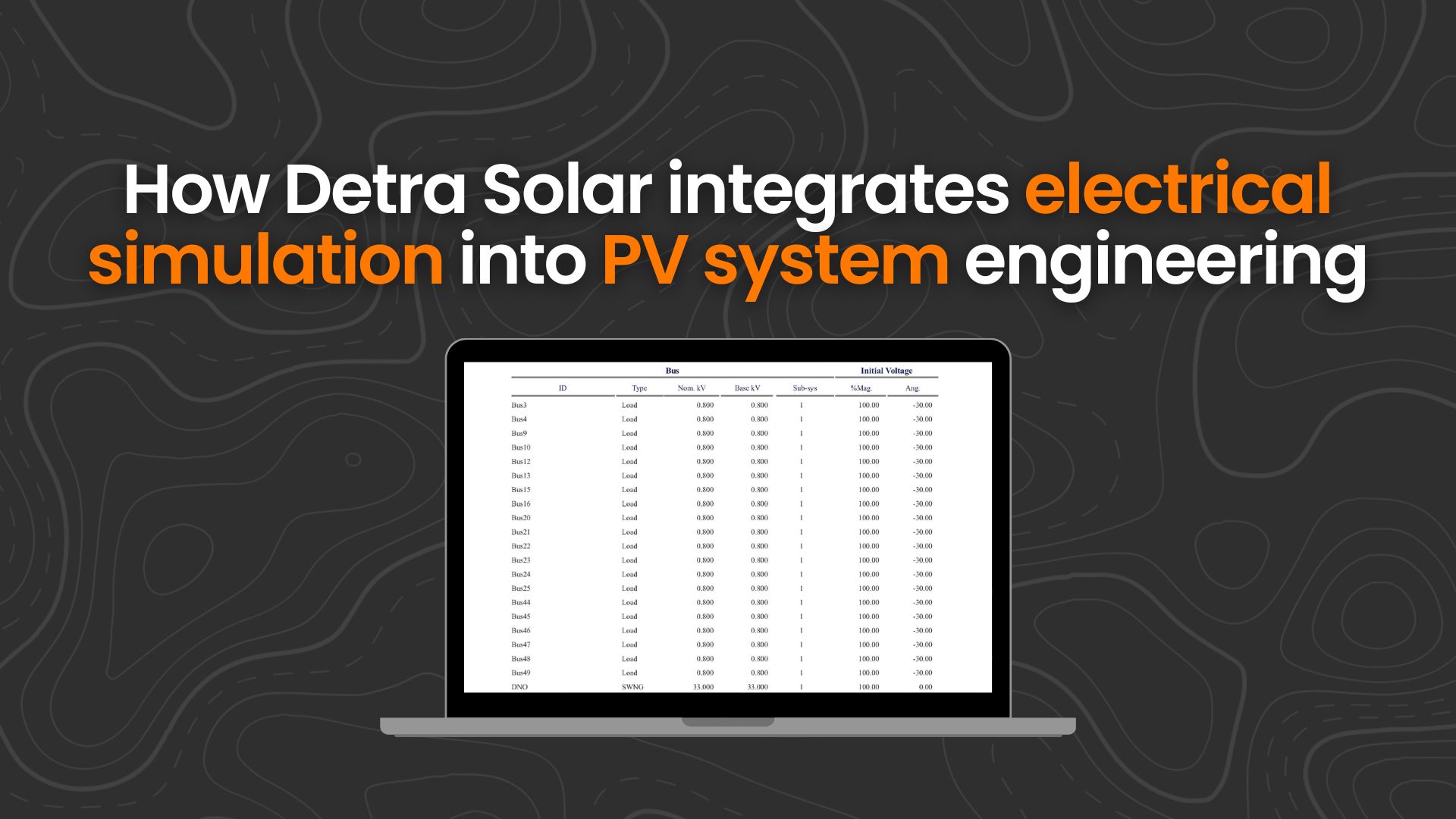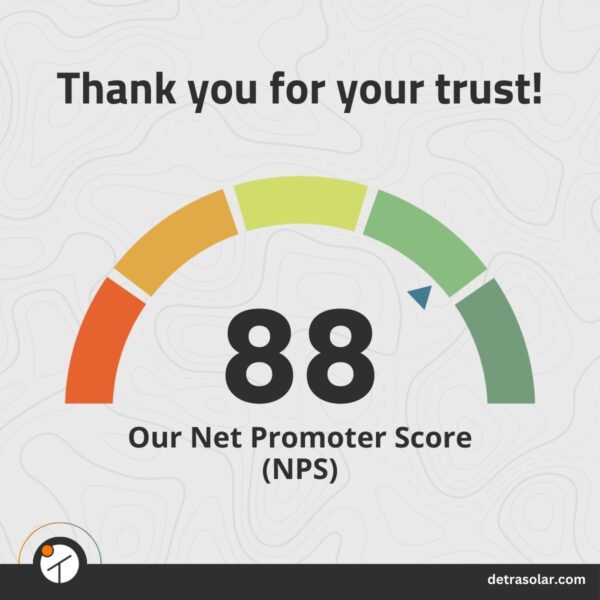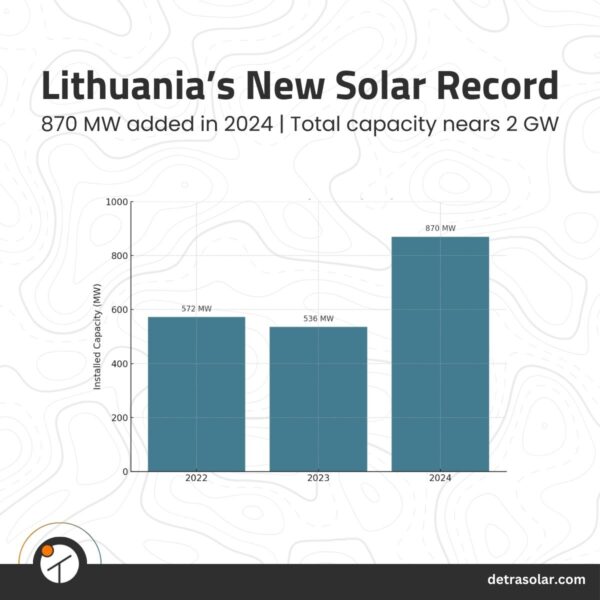Powerful Design Backed by ETAP: What This Software Means for Your Solar Projects

At Detra Solar, we believe that better tools lead to better outcomes. One such tool is ETAP—a leading electrical system modeling platform that plays a key role not just in advanced simulation, but also in laying the foundation for digital twin models of PV systems.
As PV projects grow in scale and complexity, advanced electrical simulation is no longer a “nice to have” – it’s essential. With ETAP, we can go beyond standard compliance and help you uncover design opportunities that lead to better performance, reduced risk, and smarter investment decisions.
In this post, we’re putting a spotlight on how ETAP strengthens our engineering process and unlocks smarter, more reliable solar designs.
What is ETAP, and why does it matter?
ETAP is a powerful software platform, widely adopted across the energy industry for simulating, analyzing, and optimizing electrical power systems.
By leveraging ETAP, we are able to consistently deliver detailed electrical calculations and simulations—supporting high levels of accuracy, safety, and efficiency across complex solar projects.
When Do We Use ETAP in Solar Projects?
ETAP-based simulations are typically performed in later project stages, including FEED (Front-End Engineering Design) and Construction, where detailed electrical accuracy is essential. It’s also used during Design Optimization, especially when we need to evaluate and compare multiple electrical configurations.
We also work with data from software like PVcase Ground Mount, using cable lengths and layout information to help build structured input files for ETAP simulations. While the process requires careful coordination, it ensures consistency across tools and supports more accurate electrical modeling.
Key Areas Enhanced by ETAP Simulations
Thanks to ETAP, we can offer a suite of advanced analyses as part of our PV system design services:
- Load Flow Analysis – Evaluate energy distribution under various conditions to identify potential bottlenecks and voltage issues.
- Short Circuit Studies – Ensure your system can handle fault conditions safely and effectively.
- Protection Coordination – Simulate protection device behavior to minimize system disruption in case of faults.
- Voltage Drop & Cable Ampacity Calculations – Optimize cable lengths and sizes for better performance and compliance.
- Cable Thermal Calculations – Assess heat build-up under load to ensure safety and longevity.
These simulations give you more reliable system designs, stronger technical justifications, and greater visibility into how your assets will perform.
Curious how these calculations look in practice?
Our deliverables include detailed reports with both numerical results and visual outputs, such as diagrams and schematics.
📄 See an example of a Short Circuit Analysis performed using ETAP:
Real-world application: How We Use ETAP in Practice
ETAP helps us move beyond generic solutions. For instance, we use it daily to support complex trench designs. When dealing with cable intersections or multiple cable types in a single trench, ETAP allows us to simulate how those cables should be installed to ensure optimal performance and safety.
In the past, validating custom trench configurations meant working within the limits of predefined layouts based on IEC standards. With ETAP, we’re able to simulate and verify more complex, site-specific solutions—bringing added precision to our cable installation strategies.
And that’s just one use case. It also supports load flow, short-circuit analysis, protection coordination, and more.
What types of projects benefit most?
All PV projects can benefit from ETAP-based simulations. However, it’s especially valuable for complex, utility-scale, and grid-interconnected systems, where in-depth electrical analysis is essential for making informed design decisions and complying with grid requirements.
ETAP + Digital Twins: A Step Toward Smarter PV Systems
Digital twins—virtual replicas of real PV systems—are changing how we plan, operate, and maintain solar plants. ETAP plays a key role by delivering the electrical simulation layer of these twins.
By combining ETAP outputs (like cable voltage drop losses or load flows (evaluating the efficiency)) with 3D terrain models, shading analysis, and equipment metadata from tools like PVcase, we help clients build data-driven systems ready for yield production forecasts, performance monitoring and predictive maintenance.
As the industry moves toward more integrated, lifecycle-aware design, ETAP’s role only grows stronger.
What’s in it for you?
In short, ETAP means:
✅ More advanced electrical simulations
✅ Improved design accuracy
✅ Enhanced safety and compliance assurance
✅ Transparent, data-driven decision-making
Whether you’re planning a new utility-scale PV system or refining an existing one, our ETAP-powered insights will help you make better technical and financial decisions.
📩 Looking to enhance your project with advanced electrical simulations? Get in touch to explore ETAP-enabled design support.







